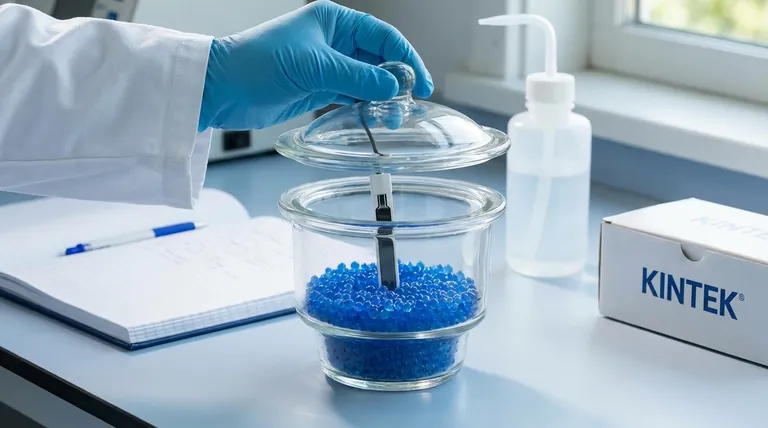For long-term storage, a glassy carbon electrode must be thoroughly cleaned, completely dried, and then stored in a dry, clean, and protected environment. The primary goal is to shield the sensitive electrode surface from environmental contaminants like moisture, dust, and corrosive vapors that can degrade its performance over time.
The core principle of long-term electrode storage is to achieve a passive, stable state. This is accomplished by meticulously cleaning and drying the surface before placing it in a controlled, non-corrosive environment, such as a desiccator, to prevent contamination and ensure its readiness for future experiments.

Why Proper Storage is Critical
A glassy carbon electrode (GCE) is a high-performance tool whose effectiveness depends entirely on the state of its surface. This surface is highly susceptible to contamination, which can block active sites and lead to inaccurate and irreproducible results.
The Goal: Preventing Surface Contamination
The seemingly smooth surface of a GCE can easily adsorb molecules from the atmosphere, including moisture, dust, and organic vapors common in a lab environment. Long-term exposure leads to a contaminated surface that requires extensive and sometimes aggressive pre-treatment to restore.
The Goal: Avoiding Physical and Chemical Damage
Improper storage can also lead to physical damage, such as scratches that permanently alter the electrode's electrochemical behavior. Exposure to corrosive fumes or high temperatures can also cause irreversible changes to the electrode material or its housing.
The Definitive Long-Term Storage Protocol
Follow these steps precisely to ensure the longevity and performance of your GCE.
Step 1: Thorough Cleaning
Immediately after your final experiment, rinse the electrode surface thoroughly. Start with deionized water to remove buffer salts and water-soluble species, followed by an ethanol rinse to remove organic residues and aid in drying.
If the electrode has been heavily used, a more intensive cleaning, such as a brief soak in a 1:1 nitric acid solution, may be warranted. However, ensure it is completely rinsed with deionized water afterward.
Step 2: Meticulous Drying
The electrode must be completely dry before storage. The best methods are to let it air-dry at room temperature or use a gentle stream of nitrogen gas.
Never use high-heat methods, such as baking under an infrared lamp. Intense heat can alter the surface chemistry of the glassy carbon or damage the electrode's insulating body.
Step 3: Protective Storage
Once clean and dry, place the electrode in a secure container. The ideal storage location is a desiccator or a sealed container with a desiccant. This provides a dry, clean, and non-corrosive environment.
Ensure the electrode is protected from strong light and high temperatures. Storing it in its original box inside a desiccator is an excellent practice.
Common Pitfalls to Avoid
Mistakes in storage are common and can significantly shorten the effective life of an electrode.
Pitfall: Insufficient Cleaning Before Storage
Storing a dirty electrode is the most common mistake. Contaminants left on the surface for long periods can become more strongly adsorbed or "baked in," making them significantly harder to remove later. Always clean it immediately after use.
Pitfall: Storing the Electrode Wet or "Ready to Use"
While immersing an electrode in a solution (like dilute nitric acid) can be a valid method for very short-term storage between experiments in a single day, it is incorrect for long-term storage. This practice can lead to solution evaporation, concentrating contaminants on the surface, and does not provide a stable, passive state.
Pitfall: Leaving the Electrode Exposed
Never store an electrode unprotected on a lab bench or in a drawer. This exposes it to dust, airborne contaminants, and the risk of physical damage from being knocked over or scratched.
Preparing the Electrode After Storage
Even with perfect storage, you must prepare the electrode before its next use to ensure optimal performance.
The Importance of Re-Activation
The electrode surface, while clean, will be electrochemically passive after long-term dry storage. It requires a pre-treatment cycle to restore its activity and produce a reliable, low-background signal.
A Standard Pre-Treatment Cycle
A typical procedure involves inspecting the electrode, polishing its surface with fine alumina powder to expose a fresh surface, and then performing an electrochemical activation, such as cycling the potential in a standard solution (e.g., potassium ferricyanide) to verify its performance.
Making the Right Choice for Your Goal
Your storage strategy depends on the intended period of non-use.
- If your primary focus is preserving the electrode for weeks or months: Meticulously clean the electrode, dry it completely, and store it in a desiccator.
- If your primary focus is keeping the electrode ready between experiments on the same day: Immerse the cleaned tip in a 1:1 nitric acid solution, but rinse it thoroughly with DI water before the next use.
- If your primary focus is maximizing data accuracy and reproducibility: Always perform a full pre-treatment protocol (polish and activate) before starting a new set of experiments, regardless of how the electrode was stored.
Proper care and storage are not just about maintenance; they are fundamental to generating reliable and reproducible electrochemical data.
Summary Table:
| Step | Key Action | Purpose |
|---|---|---|
| 1. Clean | Rinse with DI water & ethanol; use nitric acid if needed. | Remove all chemical residues and contaminants. |
| 2. Dry | Air-dry or use a gentle nitrogen stream. | Prevent moisture-related damage and contamination. |
| 3. Store | Place in a desiccator or sealed container with desiccant. | Protect from dust, moisture, and corrosive vapors. |
| 4. Pre-Treat | Polish and electrochemically activate before next use. | Restore a fresh, active surface for accurate results. |
Generate Reproducible Data with Confidence
Proper electrode storage is fundamental to experimental success. KINTEK specializes in high-quality lab equipment and consumables, including the reliable supplies you need for meticulous electrode care.
Let us support your laboratory's precision:
- Ensure consistent results with our range of cleaning and storage solutions.
- Protect your investment in sensitive instrumentation with recommended practices and products.
- Maximize uptime and accuracy for your electrochemical analyses.
Ready to optimize your lab's workflow? Contact our experts today to discuss your specific needs and how we can help you achieve superior performance.
Visual Guide

Related Products
- Glassy Carbon Electrochemical Electrode
- Glassy Carbon Sheet RVC for Electrochemical Experiments
- Rotating Platinum Disk Electrode for Electrochemical Applications
- Gold Disc Electrode
- Graphite Disc Rod and Sheet Electrode Electrochemical Graphite Electrode
People Also Ask
- How is a glassy carbon electrode activated before an experiment? Achieve Clean, Reproducible Electrochemical Data
- What is a glassy carbon electrode made of? The Engineered Material Powering Electrochemical Analysis
- How should a glassy carbon electrode be polished? A Step-by-Step Guide to a Perfect Electrochemical Surface
- What is the proper procedure for cleaning a glassy carbon sheet after use? A Definitive Guide to Ensure Reliable Results
- What is the typical working electrode potential range for a glassy carbon electrode in aqueous electrolytes? A Guide to Accurate Electrochemical Measurements



















